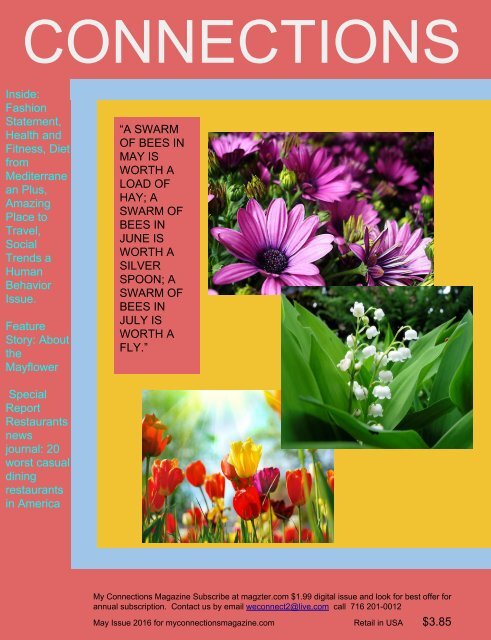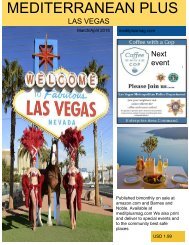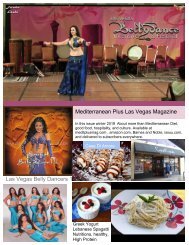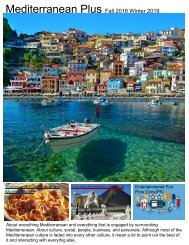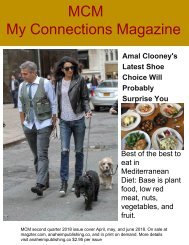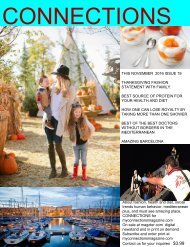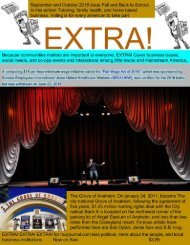CONNECTIONS THE MAY FLOWERS IISSUE MAY 2016
FAMOUS MAYFLOWER SHIP AND THE STORIES BEHIND IT. ABOUT HEALTH AND FASHION
FAMOUS MAYFLOWER SHIP AND THE STORIES BEHIND IT. ABOUT HEALTH AND FASHION
You also want an ePaper? Increase the reach of your titles
YUMPU automatically turns print PDFs into web optimized ePapers that Google loves.
<strong>CONNECTIONS</strong><br />
Inside:<br />
Fashion<br />
Statement,<br />
Health and<br />
Fitness, Diet<br />
from<br />
Mediterrane<br />
an Plus,<br />
Amazing<br />
Place to<br />
Travel,<br />
Social<br />
Trends a<br />
Human<br />
Behavior<br />
Issue.<br />
Feature<br />
Story: About<br />
the<br />
Mayflower<br />
“A SWARM<br />
OF BEES IN<br />
<strong>MAY</strong> IS<br />
WORTH A<br />
LOAD OF<br />
HAY; A<br />
SWARM OF<br />
BEES IN<br />
JUNE IS<br />
WORTH A<br />
SILVER<br />
SPOON; A<br />
SWARM OF<br />
BEES IN<br />
JULY IS<br />
WORTH A<br />
FLY.”<br />
Special<br />
Report<br />
Restaurants<br />
news<br />
journal: 20<br />
worst casual<br />
dining<br />
restaurants<br />
in America<br />
mmY c<br />
My Connections Magazine Subscribe at magzter.com $1.99 digital issue and look for best offer for<br />
annual subscription. Contact us by email weconnect2@live.com call 716 201-0012<br />
May Issue <strong>2016</strong> for myconnectionsmagazine.com Retail in USA $3.85
EXTRA!<br />
Why Amnesty dumped 200 body bags on Brighton beach<br />
After hundreds of people drowned at sea the charity has left a poignant<br />
reminder that these lives matter. on the cover.As part of Amnesty International's "Don't Let<br />
Them Drown" campaign. Below: Amnesty International France: Journalist<br />
We will never let money hide reality from us.<br />
Amnesty International is a global movement of people fighting injustice and promoting<br />
human rights.<br />
We work to protect people wherever justice, freedom, truth and dignity are denied. Currently the world’s largest grassroots<br />
human rights organization, we investigate and expose abuses, educate and mobilize the public, and help transform<br />
societies to create a safer, more just world. We received the Nobel Peace Prize for our life-saving work.<br />
http://www.amnestyusa.org/about-us
My Connections Magazine<br />
<strong>CONNECTIONS</strong> May <strong>2016</strong><br />
-Feature Cover Story:<br />
The Mayflower Page 3<br />
-Health and Fitness<br />
Why Water Is Key for Anti-Aging<br />
-PILGRIMS BEFORE <strong>THE</strong><br />
<strong>MAY</strong>FLOWER<br />
Carrying The Saints that the<br />
King of England gave them<br />
permission to leave the<br />
Church of England,<br />
“provided they carried<br />
themselves peaceably.”<br />
Page 2<br />
May Flowers Issue:<br />
-Some say Love it is a Flower<br />
HOW “<strong>THE</strong> ROSE” CAME<br />
TO BE<br />
Page 11<br />
-Med Plus:<br />
Diet Mediterranean Plus<br />
The Nation’s Restaurant News survey: Worst 20 Restaurants<br />
In The USA<br />
Page 19<br />
-Social Trends<br />
About Human behavior: Why<br />
men Forget more than women<br />
do?<br />
Page 24<br />
-Amazing Place to visit:<br />
Page 4<br />
-Fashion Statement<br />
Flower power! Why<br />
chintz is back in fashion<br />
Page 7<br />
The golden Gate bridge San<br />
Francisco Page 26<br />
1
My Connections Magazine<br />
<strong>CONNECTIONS</strong> May <strong>2016</strong><br />
Myconnectionsmagazine.com<br />
Social, culture, life style, fashion,<br />
Mediterranean plus, global, and<br />
about people.<br />
Shop online with News U.S. Journal<br />
newsusjournal.com IHOT online store<br />
magazines, books, journal, and get freebies.<br />
On sale at magzter.com look for best offer<br />
on your annual subscription, and you can<br />
have it in print by simple and quick order at<br />
either weconnect2.com or<br />
myconnectionsmagazine.com.<br />
Learn, listen, watch, and read about<br />
marketing solutions, and marketing news.<br />
PILGRIMS BEFORE <strong>THE</strong><br />
<strong>MAY</strong>FLOWER<br />
In 1608, a congregation of<br />
disgruntled English Protestants<br />
from the village of Scrooby,<br />
Nottinghamshire, left England and<br />
moved to Leyden, a town in<br />
Holland. These “Separatists” did not<br />
want to pledge allegiance to the<br />
Church of England, which they<br />
believed was nearly as corrupt and<br />
idolatrous as the Catholic Church it<br />
had replaced, any longer. (They<br />
were not the same as the Puritans,<br />
who had many of the same<br />
objections to the English church but<br />
wanted to reform it from within.)<br />
The Separatists hoped that in<br />
Holland, they would be free to<br />
worship as they liked<br />
2
My Connections Magazine<br />
<strong>CONNECTIONS</strong> May <strong>2016</strong><br />
The Separatists<br />
who founded the<br />
Plymouth Colony<br />
referred to<br />
themselves as<br />
“Saints,” not<br />
“Pilgrims.” The<br />
use of the word<br />
“Pilgrim” to<br />
describe this<br />
group did not<br />
become common<br />
until the colony’s<br />
bicentennial.<br />
menial, low-paying jobs. Even<br />
worse was Holland’s easygoing,<br />
cosmopolitan atmosphere, which<br />
proved alarmingly seductive to<br />
some of the Saints’ children. (These<br />
young people were “drawn away,”<br />
Separatist leaderWilliam<br />
Bradford wrote, “by evill [sic]<br />
example into extravagance and<br />
dangerous courses.”) For the strict,<br />
devout Separatists, this was the last<br />
straw. They decided to move again,<br />
this time to a place without<br />
government interference or worldly<br />
distraction: the “New World” across<br />
the Atlantic Ocean.<br />
<strong>THE</strong> <strong>MAY</strong>FLOWER<br />
First Thanksgiving Dinner.<br />
In fact, the Separatists (they called<br />
themselves “Saints”) did find<br />
religious freedom in Holland, but<br />
they also found a secular life that<br />
was more difficult to navigate than<br />
they’d anticipated. For one thing,<br />
Dutch craft guilds excluded the<br />
migrants, so they were relegated to<br />
First, the Separatists returned to<br />
London to get organized. A<br />
prominent merchant agreed to<br />
advance the money for their<br />
journey. The Virginia Company<br />
gave them permission to establish a<br />
settlement, or “plantation,” on the<br />
East Coast between 38 and 41<br />
degrees north latitude (roughly<br />
between the Chesapeake Bay and<br />
3
My Connections Magazine<br />
<strong>CONNECTIONS</strong> May <strong>2016</strong><br />
the mouth of the Hudson River).<br />
And the King of England gave them<br />
permission to leave the Church of<br />
England, “provided they carried<br />
themselves peaceably.”<br />
sailor had been “a proud and very<br />
profane yonge man.”)<br />
In August 1620, a group of about 40<br />
Saints joined a much larger group<br />
of (comparatively) secular<br />
colonists–“Strangers,” to the<br />
Saints–and set sail from England<br />
on two merchant ships: the<br />
Mayflower and the Speedwell. The<br />
Speedwell began to leak almost<br />
immediately, however, and the<br />
ships headed back to port. The<br />
travelers squeezed themselves and<br />
their belongings onto the Mayflower<br />
and set sail once again.<br />
Love is a flower<br />
HOW “<strong>THE</strong> ROSE”<br />
CAME TO BE<br />
People often ask me what inspired me to<br />
write The Rose. Here is the story:<br />
some time in 1970-something.<br />
I was listening to the radio. A song came on the radio. It was<br />
Because of the delay caused by the<br />
leaky Speedwell, the Mayflower had<br />
to cross the Atlantic at the height of<br />
storm season. As a result, the<br />
journey was horribly unpleasant.<br />
Many of the passengers were so<br />
seasick they could scarcely get up,<br />
and the waves were so rough that<br />
one “Stranger” was swept<br />
overboard and drowned. (It was<br />
“the just hand of God upon him,”<br />
Bradford wrote later, for the young<br />
“MAGDALENA” by Danny O’Keefe, sung by Leo Sayer. I<br />
liked it immediately. My favorite line was “Your love is like a<br />
razor. My heart is just a scar.”I thought,”Ooh, I love that<br />
lyric.”<br />
As I continued to drive down the road the thought came, I<br />
don’t agree with the sentiment. I don’t think love is like a<br />
razor. (I was younger then.) What, then, do I think love is?<br />
Suddenly, it was as if someone had opened a window in the<br />
top of my head. Words came pouring in. I had to keep<br />
reciting them to myself as I drove faster and faster towards<br />
home, so I wouldn’t forget them. I screeched into my drive<br />
way, ran into the house, past various bewildered dogs and<br />
4
My Connections Magazine<br />
<strong>CONNECTIONS</strong> May <strong>2016</strong><br />
cats and husbands, and sat down at the piano. Ten minutes<br />
later, <strong>THE</strong> ROSE was there.<br />
to the Universe for speaking to me in the first place and for<br />
showing me what I truly believe.<br />
I called my husband, George, into the room and played it for<br />
him, as I always did with my new songs. He listened, and<br />
quietly said to me, “You’ve just written a standard.” I<br />
protested that no one but my pals would ever hear it. (This is<br />
long before I had ever recorded anything.) He said,”Mark my<br />
words, something is going to happen with this song.”<br />
*Here are the lyrics:<br />
Some say love, it is a river<br />
That drowns the tender reed<br />
Some say love, it is a razor<br />
That leaves your soul to bleed<br />
Some say love, it is a hunger<br />
An endless aching need<br />
A year or so later, a great young songwriter named Michele<br />
Brourman, who became my primary musical collaborator and<br />
best friend, said “Listen. There is this movie coming out<br />
called “The Rose”. They are looking for a title tune. Do you<br />
want me to submit this to them?” I had never really tried to<br />
submit this song to anyone. I didn’t consider myself a song<br />
writer at the time. So I said, “Sure.” Originally the film had<br />
been called <strong>THE</strong> PEARL, which was Janis Joplin’s nick<br />
name. But her family refused permission to use that name.<br />
Lucky for me. “Pearl” is MUCH harder to rhyme.<br />
I say love, it is a flower<br />
And you, its only seed<br />
It’s the heart that fears the breaking<br />
That never learns to dance<br />
It’s the dream, afraid of waking<br />
That never takes the chance<br />
It’s the one who won’t be taken<br />
Who cannot seem to give<br />
And the soul, afraid of dying<br />
That never learns to live<br />
She submitted the tune to the producers, who HATED it.<br />
They thought it was dull and a hymn and NOT rock and roll<br />
and totally wrong. They put it in the reject box. But the divine<br />
Paul Rothchild, who was the music supervisor on the film,<br />
and had been Janis Joplin’s producer, hauled it out and<br />
asked them to reconsider. They again said no. So he mailed<br />
it to Bette. She liked it, and that’s how it got into the film and<br />
changed my life forever.<br />
When the night has been too lonely<br />
And the road has been too long<br />
And you think that love is only for the lucky and the strong<br />
Just remember in the winter<br />
Far beneath the bitter snow<br />
Lies the seed<br />
That with the sun’s love, in the spring<br />
Becomes the flowers<br />
I have never written another song as quickly. I like to think I<br />
was the window that happened to be open when those<br />
thoughts needed to come through. I am eternally grateful…<br />
Red Cedar Books online store at Lulu.com<br />
featuring Belly Flat and six pack Abs.<br />
to Bette… to Paul Rothchild… to Bill Kerby, who wrote the<br />
screenplay…to my friend who first submitted it for me… and<br />
5
My Connections Magazine<br />
<strong>CONNECTIONS</strong> May <strong>2016</strong><br />
6
My Connections Magazine<br />
<strong>CONNECTIONS</strong> May <strong>2016</strong><br />
Fashion Statement Flower Style<br />
Flower power! Why<br />
chintz is back in fashion<br />
more at Red Cedar Books<br />
At lulu.com/spotlight/redcedars<br />
White floral<br />
dress with sleeves, £790, Emilia Wickstead<br />
at Matches Fashion.<br />
<br />
Kate Finnigan, FASHION FEATURES<br />
DIRECTOR<br />
7 <strong>MAY</strong> <strong>2016</strong> • 6:30AM<br />
I realise that saying florals are a la<br />
mode for summer is about as surprising<br />
as claiming boots are in vogue for<br />
walking holidays, but those accustomed<br />
to these pages will know that fashion<br />
trends in florals can veer wildly, yes,<br />
WILDLY, I say, from one year to<br />
another. Sometimes the catwalks sprout<br />
nothing but ditsy prints, sometimes<br />
they’re awash with painterly petals,<br />
sometimes abstract splodges.<br />
Red Cedar Books<br />
Karen Walker x Liberty print<br />
sunglasses, £195, Liberty; Framed<br />
Varsity Jacket, £650, Coach<br />
But for the summer of <strong>2016</strong> I have to tell<br />
you that we are knee-deep in suburban<br />
soft-furnishings. Shy not away from the<br />
1930s tea-room look: chintz is in.<br />
With the sun finally making an<br />
appearance, temperatures up and<br />
Chelsea Flower Show on the horizon, we<br />
are now in optimum position to embrace<br />
the busy floral. Matchesfashion.com<br />
have timed it well with a capsule<br />
collection of what they’re calling “retro<br />
florals in orange, raspberry and lilac”<br />
7
My Connections Magazine<br />
<strong>CONNECTIONS</strong> May <strong>2016</strong><br />
created by the designer Emilia<br />
Wickstead, which launches this week.<br />
Both the London brand House of<br />
Hackney and the Bath-based designer<br />
Joe Richards have used the botanical<br />
prints of William Morris in their current<br />
collections.<br />
Floral midi skirt, £550, Emilia<br />
Wickstead at Matches Fashion<br />
Wickstead’s main collection for spring<br />
included similar prints, on light-as-afeather<br />
silk gazar. “I always like to make<br />
a collection very twee but also very<br />
modern,” says the designer. Wickstead<br />
is someone very much on the side of<br />
women and whose clothes are worn by<br />
the Duchess of Cambridge, Samantha<br />
Cameron and many an elegant red<br />
carpet regular. If she approves of a 'twee’<br />
and chintzy floral we are in no position<br />
to argue. As she says: “I design for<br />
women of all ages, myself [she’s in her<br />
30s], my mother, a woman in her<br />
twenties.”<br />
Meanwhile, Gucci is rolling out rose and<br />
hydrangea smothered shoes, bags,<br />
dresses and sweatshirts in quantities not<br />
seen since the Women’s Institute last<br />
had a used-curtains sale.<br />
Another hip brand of the moment,<br />
Vetements, is selling oversized floral<br />
dresses in what Natalie Kingham,<br />
buying director of matchesfashion.com,<br />
calls “a 1980s wallpaper” print.<br />
Blue Floral Jacquard Dress, £120,<br />
Laura Ashley; Floral bird empire midi<br />
dress, £45.99, Warehouse<br />
For anyone alive in the 1970s these<br />
patterns will have been more familiar as<br />
curtains and cushions. We had both, oh<br />
la-di-dah. Surprising, isn’t it? But do not<br />
mock the chintz. It got a bad press in the<br />
late 20th century for its middle-class<br />
aspirations, but it has a more rock 'n'<br />
roll history than you might think.<br />
In the 17th and 18th centuries chintz<br />
was the subject of both protest and<br />
punishment. Any stylish lady strolling a<br />
London square in a dyed floral cotton<br />
number was at risk of being fined a<br />
whopping £10 - and I don’t mean by the<br />
Fashion Police. In the 1700s it really was<br />
illegal to wear chintz in England, thanks<br />
to a raft of legislation that was designed<br />
to protect English linen, wool and silk<br />
8
My Connections Magazine<br />
<strong>CONNECTIONS</strong> May <strong>2016</strong><br />
weavers who were unable to produce the<br />
by-now popular fabric.<br />
When merchants started importing<br />
them in the 17th century, the surge in<br />
popularity alarmed the linen, wool and<br />
silk weavers of England who didn’t have<br />
access to cotton nor the fast dyes to<br />
make the exotic, hand painted textiles.<br />
With everyone who was anyone<br />
suddenly simply mad about chintz it<br />
threatened the ruin of the European<br />
textile market.<br />
Gucci leather trimmed printed canvas<br />
shoulder bag, £600, Net-a-Porter; Mule<br />
sandals, £45.99, Zara<br />
Imported from India, chintz had been<br />
used initially as a furnishing fabric. But<br />
when the upper classes handed down<br />
their older textiles to their household<br />
servants these exotic patterns started<br />
being used as clothes linings and then<br />
garments.<br />
“In an interesting move this was then<br />
adopted by the higher classes who also<br />
saw the attraction in wearing these fast<br />
bright colours on clothes,” says Divia<br />
Patel, curator of The Fabric of India, last<br />
year’s exhibition at the Victoria & Albert<br />
Museum. “The furnishing fabrics<br />
required large flowers, but when people<br />
started wearing them the merchants<br />
went back to India saying that a<br />
European audience might prefer, say, a<br />
cream background to a red and smaller<br />
sprays of flowers to the larger, so you<br />
started getting smaller patterns and a<br />
different look to the fabrics.”<br />
Black sleeveless floral dress, £590,<br />
Emilia Wickstead at Matches Fashion<br />
Such was the risk to the domestic textile<br />
industry that in the late 17th century five<br />
thousand weavers protested outside the<br />
Houses of Parliament. In 1701 imports<br />
of Indian dyed or printed cottons were<br />
banned and in 1720 Parliament enacted<br />
a law that forbade 'the Use and Warings<br />
in Apparel of imported chintz, and also<br />
its use or Wear in or about any Bed,<br />
Chair, Cushion or other Household<br />
furniture.” The ban remained in place<br />
for fifty years, by which time European<br />
manufacturers had worked out how to<br />
do it themselves.<br />
9
My Connections Magazine<br />
<strong>CONNECTIONS</strong> May <strong>2016</strong><br />
from £1060, Fendi at Selfridges<br />
Bag,<br />
It doesn’t take perhaps quite as much<br />
gall to wear a chintz now as it did in the<br />
1700s (it not being a crime and all), but<br />
still a vibrant print can be tricky. So how<br />
to wear one?<br />
Natalie Kingham says Wickstead’s<br />
'Dolce Vita feel’ collection suits a lot of<br />
different body shapes and different ages.<br />
“The skirts look great teamed with a<br />
knotted denim or white shirt or a<br />
cardigan, and the frocks work with gold<br />
hoop earrings, a black heel or an<br />
espadrille and a basket.”<br />
Submit your article, post, content, and<br />
photography with My Connections<br />
Magazine (<strong>CONNECTIONS</strong>at<br />
myconnectionsmagazine.com<br />
Actress<br />
Stacy Martin wore Miu Miu to the Met Gala<br />
earlier this week. CREDIT: GETTY<br />
Wickstead herself has been seen wearing<br />
similar skirts with a plain white t-shirt.<br />
While Vetement’s die-hard fashion fans<br />
will be wearing chunky heeled black<br />
ankle boots with their tent-ish, floral<br />
frocks, for event dressing you may prefer<br />
to take your lead from the elegant<br />
actress Stacy Martin’s wallpaper-ish but<br />
nonetheless stunning floral-sprigged<br />
Miu Miu gown worn at the Metropolitan<br />
Museum of Art’s Gala earlier this week.<br />
Martin accessorized with green suede<br />
sandals and chandelier earrings – what<br />
else with wallpaper?<br />
We are always looking for talents writers<br />
contributors who are out to promote their<br />
contents and seek readers.<br />
We provide editing and enhancement, over tens<br />
of thousands registered members looking<br />
forward for new topics. Please be kind, take<br />
your time, follow simple professional format. We<br />
are proud to lift you up to your ultimate success.<br />
We like to be there with you and for you for<br />
stories behind your making.<br />
and policewithoutborder.com<br />
on sale at magzter.com<br />
10
My Connections Magazine<br />
<strong>CONNECTIONS</strong> May <strong>2016</strong><br />
Health and Fitness<br />
Why Water Is Key for Anti-<br />
Aging<br />
To me, water is a gift from above, a living,<br />
nourishing substance important not just for life<br />
but for quality of life as well. Yet water is so<br />
taken for granted that people don’t tend to think<br />
of it in health or anti-aging terms. They should.<br />
Don’t Forget Nutrient # 1 −<br />
Water<br />
“Water contributes much towards health.” −<br />
Hippocrates, On Airs, Waters, and Places<br />
unwatered house plants. They hardly drank<br />
water. They drank coffee and sodas, and, not<br />
unfrequently, too much alcohol. But not<br />
what their body needed: water. They were<br />
unwell and they were dehydrated. To what<br />
degree dehydration contributed to their<br />
conditions, I couldn’t precisely say, but I<br />
always had a hunch it was a contributing<br />
factor. I used to ask patients about how<br />
much water they drank on a daily basis. It<br />
wasn’t much. Maybe a glass. Two at the<br />
most. Maybe nothing.<br />
I always told them to drink more.<br />
In his writings on public hygiene,<br />
Hippocrates (460-354 B.C.), considered the<br />
Father of Medicine, emphasized the<br />
importance of water in the maintenance of<br />
health. In our modern age, twenty-five<br />
centuries later, no one doubts the validity of<br />
the wise Greek’s words.<br />
In a review article (Popkin) on the role of<br />
water in health, nutrition researchers at the<br />
University of North Carolina summed it up<br />
succinctly: “Water is essential to life. Water<br />
represents a critical nutrient whose absence<br />
will be lethal within days.”<br />
How important is water? Just look at a house<br />
plant when you forget to water it, and look<br />
again after you do.<br />
In my medical practice, I used to see many<br />
patients who were dried-up like those<br />
Unfortunately, for many years I didn’t<br />
practice what I personally preached. I recall<br />
visiting a doctor friend one time and he<br />
checked me out and said I was extremely<br />
dehydrated. My joints were rather stiff at the<br />
time, and lack of hydration could have been<br />
partly to blame. Since that time, I’ve made it<br />
a point to put water into my daily routine.<br />
Water and Heart Disease<br />
You’d never imagine it, but plain old water<br />
is probably one of the most overlooked tools<br />
against heart disease. Researchers from<br />
Loma Linda University in California<br />
confirmed this some years ago by checking<br />
the water intake of about twenty thousand<br />
well-educated men and women (ages 38 to<br />
100) as a possible risk factor for fatal<br />
coronary artery disease (heart attacks). In a<br />
2002 study (Chan), they concluded that<br />
11
My Connections Magazine<br />
<strong>CONNECTIONS</strong> May <strong>2016</strong><br />
water indeed had a strong protective<br />
association for both sexes.<br />
To be sure, statistical studies can only<br />
provide an indication, and are not outright<br />
proof of cause and effect. What was<br />
interesting to me is that the researchers here<br />
found elevated viscosity (blood thickness),<br />
volume of red blood cells (hematocrit), and<br />
fibrinogen (a protein involved in the clotting<br />
process) among individuals who drank less<br />
than two glasses of water daily compared to<br />
those who drank five or more. When<br />
elevated, and even at high normal range,<br />
these factors are associated with coronary<br />
heart disease. They make blood thicker,<br />
something I have consistently found among<br />
heart and diabetic patients. Elevated values,<br />
in fact, are found years before acute<br />
cardiovascular problems show up, in early<br />
stages of atherosclerosis (arterial disease)<br />
and high blood pressure. Such elevations<br />
can result from chronic dehydration.<br />
Viscosity is a big deal – an important, but<br />
overlooked risk factor for cardiovascular<br />
disease. The thicker your blood, the slower<br />
it flows through the thousands of miles of<br />
your circulatory system and the greater the<br />
risk of nasty things happening,<br />
like inflammation, clots, plaque, and cardiac<br />
and vascular trouble. Your heart works<br />
harder. Thicker blood is often full of toxins,<br />
bacteria, excess glucose and insulin, and<br />
other substances that stoke inflammation<br />
and damage to the fragile endothelial lining<br />
of blood vessels. Healthy blood is more like<br />
the consistency of wine, and not sludgy like<br />
ketchup.<br />
Many of my patients were dehydrated and<br />
that status likely contributed to their thicker<br />
blood. However, the research (see Sugaya)<br />
doesn’t show that flooding your body with<br />
water will necessarily decrease viscosity, or<br />
prevent heart attacks and stroke. It will, for<br />
sure, increase urinary frequency. The key<br />
thing is not to become dehydrated.<br />
One of the best, and simplest, ways to<br />
reduce blood viscosity is to “Earth” or<br />
“ground.” To ground is to provide your body<br />
with the natural, gentle electric energy<br />
omnipresent on the surface of the Earth by<br />
regularly walking barefoot outside or<br />
sleeping, working, relaxing indoors in direct<br />
skin contact with conductive sheets, mats,<br />
bands, or patches. In my experience, such<br />
contact, whether outside or inside, has a<br />
blood-thinning effect and improves<br />
circulation. I conducted a study on this<br />
amazing effect, which I believe has<br />
significant implications for both prevention<br />
and treatment of cardiovascular disease. You<br />
can learn more about Earthing here, and read<br />
the blood viscosity study here.<br />
“Dr. Batman” − the Water<br />
Doctor<br />
12
My Connections Magazine<br />
<strong>CONNECTIONS</strong> May <strong>2016</strong><br />
You may never have heard of Fereydoon<br />
Batmanghelidj, M.D., who became a<br />
celebrity in the health world during the<br />
1980s and 1990s for his unusual story and<br />
work with water. Batmanghelidj<br />
(pronounced Batman-gey-lij) studied the<br />
effects of water (or lack of it) in the human<br />
body for more than twenty-five years before<br />
his death in 2004.<br />
Often referred to as “Dr. Batman” because<br />
Americans couldn’t pronounce his name, he<br />
championed the healing benefits of water in<br />
lectures and books. He believed that chronic<br />
dehydration contributes to many of today’s<br />
serious illnesses, such as heart disease,<br />
asthma, hypertension, lupus, and multiple<br />
sclerosis. He often said that a chronic lack of<br />
water caused the body to cry out in pain, and<br />
pointed to arthritis and joint pain as an<br />
example.<br />
“If you have chronic pain in the spine,<br />
hands, or legs, that means those joints are<br />
thirsting for water,” he said. “You are not<br />
drinking enough water. The pain is due to<br />
dehydrated joints, plus wear and tear, and<br />
the inability of the cartilage to repair the<br />
damage.”<br />
His interest in water went back to his native<br />
Iran where the London-trained physician<br />
was jailed as a political prisoner from 1979<br />
to 1982. When fellow prisoners asked him to<br />
help another man suffering from an acute<br />
peptic ulcer attack, all he had to offer was<br />
water. He gave the man two glasses of<br />
water. To his surprise, the prisoner’s pain<br />
vanished in minutes. During the next two<br />
years as one of the prison’s doctors, he<br />
researched and applied the use of water for<br />
treating people under stress. A clinical<br />
report describing his treatment of more than<br />
three thousand peptic ulcer cases with water<br />
appeared in a 1983 issue of theJournal of<br />
Clinical Gastroenterology.<br />
After his release from prison, he found his<br />
way to the United States and devoted his<br />
full-time attention to researching, writing,<br />
and lecturing about dehydration-related<br />
health problems. Part of his lasting legacy is<br />
a wonderful book I highly recommend<br />
reading: Your Body’s Many Cries for Water<br />
(available throughwww.watercure.com).<br />
Water Facts<br />
According to University of North Carolina<br />
experts (see Popkin), thirst plays little dayto-day<br />
role in the control of water intake in<br />
healthy people. Here are some other<br />
facts about water and your health from their<br />
review:<br />
Total fluid intake increased from 79<br />
fluid ounces daily in 1989 to 100 in<br />
2001 among U.S. adults, all from<br />
caloric beverages like sodas.<br />
The elderly have low water reserves<br />
compared to younger people. Because of<br />
13
My Connections Magazine<br />
<strong>CONNECTIONS</strong> May <strong>2016</strong><br />
<br />
<br />
<br />
<br />
<br />
this, it is prudent for seniors to learn to<br />
get into the water drinking habit more.<br />
Body water loss through sweat is an<br />
inherent cooling mechanism in hot<br />
weather and during physical activity.<br />
Sweat loss needs to be compensated for<br />
with fluid intake.<br />
Dehydration can influence cognition and<br />
even a mild level can disrupt mood,<br />
concentration, alertness, and short-term<br />
memory in children, young adults, and<br />
the elderly.<br />
Constipation has a number of causes,<br />
including medications, inadequate fiber,<br />
poor diet, and illness. An increase in<br />
fluid intake is popularly recommended<br />
as a remedy, but the evidence suggests<br />
that more liquid is only effective for<br />
individuals who are dehydrated. In the<br />
elderly, however, those who consume<br />
the least amount of fluid have over twice<br />
the frequency of constipation compared<br />
to those consuming the most.<br />
Your kidneys have a primary role in<br />
regulating water balance and blood<br />
pressure as well as removing waste from<br />
the blood stream and excreting it<br />
through the urine. Water is necessary for<br />
the filtration of waste.<br />
Dehydration can lead to headaches,<br />
including migraine, and in the case of<br />
water-induced headache, drinking water<br />
often provides relief within 30 minutes<br />
to 3 hours. The role of water, however,<br />
as a form of prevention in the general<br />
<br />
<br />
population of headache sufferers, is not<br />
known.<br />
The skin contains about 30 percent<br />
water, but there is little evidence<br />
indicating that drinking more water<br />
every day (such as 8 to 10 glasses) will<br />
flush toxins from the skin and generate a<br />
“glowing complexion,” as is widely<br />
touted in beauty magazines and via the<br />
Internet. Adequate skin hydration won’t<br />
prevent wrinkles or other signs<br />
of aging that are typically connected to<br />
genetics, the sun, and environmental<br />
damage. Skin dryness is usually linked<br />
to exposure to dry air, prolonged contact<br />
with hot water, and scrubbing with soap,<br />
as well as certain medical conditions<br />
and medications.<br />
Good water intake reduces the risk of<br />
developing stones in the urinary tract<br />
(kidneys, bladder, and urethra).<br />
Can Water Help You Lose<br />
Weight?<br />
Yes, according to a 2010 study (Dennis),<br />
and all it takes is just two 8-ounce glasses of<br />
water just before you eat.<br />
In the study, researchers from Virginia Tech<br />
found that over a 12 week period, dieters<br />
who drank water before meals, three times a<br />
week, lost about 5 pounds more than dieters<br />
who did not increase their water intake.<br />
14
My Connections Magazine<br />
<strong>CONNECTIONS</strong> May <strong>2016</strong><br />
Previous studies have hinted that drinking<br />
water before meals reduces calorie intake.<br />
But this was the first study that<br />
compared weight loss among two groups of<br />
dieters randomly selected to either drink<br />
water before low-calorie meals or not to.<br />
Forty-eight adults (55-75 years) participated<br />
in the study. After 12 weeks, the water<br />
group lost on average 15.5 pounds, the nondrinkers,<br />
about 11.<br />
Brenda Davy, Ph.D., the lead author,<br />
indicated that water’s effectiveness may<br />
simply be due to the fact it supplies no<br />
calories and fills up the stomach. People feel<br />
fuller and eat less.<br />
If you are overweight and stumped about<br />
how to lose weight, try a double shot of<br />
water before meals the next time you go on<br />
a diet. You will likely not find anything<br />
simpler or less expensive. And, in the<br />
process, you will contribute to your<br />
hydration status.<br />
How Much Water Should<br />
You Drink?<br />
Obviously, in hot weather or when you<br />
sweat a lot, you need to compensate for the<br />
fluid loss from your body. One 2012 study<br />
(Armstrong) conducted with a group of 25<br />
young women found that even mild<br />
dehydration, a result of not drinking enough<br />
fluids to replace fluids lost through exercise,<br />
can generate adverse changes in mood,<br />
vigor, and fatigue, as well as increased<br />
headaches and difficulty concentrating<br />
among young women.<br />
The overall issue of how-much-to-drink is<br />
somewhat complex, because physical<br />
activity and energy expenditures affect the<br />
need for water, as does body size. Other<br />
considerations are the water content of food,<br />
such as milk, fruits, and vegetables, and the<br />
growing increase in consumption of<br />
sweetened beverages. Researchers (Popkin)<br />
admit that there is little understanding<br />
globally of measuring total fluid intake or<br />
even of measuring the hydration status of<br />
individuals.<br />
According to the U.S. Institute of Medicine,<br />
the generally recommended amounts for<br />
daily water consumption, including from<br />
beverages and food, are 2.7 liters (91<br />
ounces) for women and 3.7 liters (125<br />
ounces) for men. About 80 percent of total<br />
intake comes from drinking water and<br />
beverages, and the other 20 percent from<br />
food.<br />
Here’s my general advice on fluid intake,<br />
some of which is just plain old common<br />
sense:<br />
Drink water when you are thirsty.<br />
Drink more when the weather is hot and<br />
you sweat a lot from exercise.<br />
15
My Connections Magazine<br />
<strong>CONNECTIONS</strong> May <strong>2016</strong><br />
<br />
<br />
<br />
<br />
<br />
If you work at a desk, sip water<br />
throughout the day.<br />
Drink water out of glass containers. Try<br />
to avoid the plastic water bottles as they<br />
are made from many different chemicals<br />
that have the potential to leach into the<br />
water – and those chemicals your body<br />
doesn’t need whatsoever.<br />
Sip warm or hot water during a meal,<br />
not ice drinks to help with digestion.<br />
Eat fruits and vegetables high in water<br />
content. This habit provides not just<br />
fluid but vitamins, minerals, and other<br />
healthy nutrients. Soups are another<br />
good source of fluid plus nutrients.<br />
Try to avoid beverages like sodas that<br />
are sweetened with sugar, high fructose<br />
corn syrup, and other ingredients that<br />
your body doesn’t need. They provide<br />
little, if anything, in the way of<br />
nutrients, and if consumed regularly, can<br />
contribute to metabolic syndrome and<br />
diabetes, and a host of problems.<br />
Med Plus: Mediterranean Plus Primary Offering<br />
is Food and Restaurant review.<br />
There are many diets-du-jour to<br />
choose from. And most likely<br />
you’ve heard and read about<br />
most of them. But when it<br />
comes to promises of better<br />
health and a sleek physique —<br />
few can stand up to the<br />
Mediterranean diet.<br />
In fact, the benefits you gain<br />
from the foods of<br />
the Mediterranean diet are so<br />
strong, the most recent study<br />
shows the diet can decrease<br />
your risk of stroke, heart attack<br />
or death more than if you gave<br />
up all of the the bad foods, like<br />
grains, deep-fried foods and<br />
sugary sweet desserts and<br />
drinks, typical of the Western<br />
diet followed by most<br />
Americans.<br />
In other words, it looks like you<br />
have proof that you can mostly<br />
follow the healthy<br />
Mediterranean diet, eat more<br />
fresh fruits and vegetables, fish<br />
and olive oil — and cheat with<br />
some of those “guilty-pleasure<br />
foods” — yet still hold onto your<br />
health.<br />
So why is your doctor forcing<br />
you to eat only the “healthy<br />
foods?” Likely because he’s<br />
16
My Connections Magazine<br />
<strong>CONNECTIONS</strong> May <strong>2016</strong><br />
hung up on outdated advice.<br />
Because you’ll soon see that you<br />
can have your cake — or fried<br />
pie — and eat it too without<br />
going into cardiac arrest…<br />
The study, which is published in<br />
the European Heart<br />
Journal, 1 showed that for every<br />
100 people eating the highest<br />
proportion of healthy<br />
“Mediterranean” foods, there<br />
were three fewer heart attacks,<br />
strokes or deaths than<br />
compared to 100 people eating<br />
the least amount of healthy<br />
foods during nearly four years of<br />
follow-up from the time the<br />
participants joined the study.<br />
The people who participated in<br />
the study — all 15,482 of them<br />
— had been previously<br />
diagnosed with coronary artery<br />
disease. After participating in a<br />
food survey, they were given a<br />
Mediterranean diet score (MDS)<br />
which assigned points — from 0<br />
to 24 —based on their<br />
consumption of healthy foods.<br />
The amount of unhealthy foods<br />
they ate was assigned a Western<br />
diet score (WDS).<br />
The participants fell into the<br />
three major MDS score ranges:<br />
15 or over (those who ate the<br />
most amounts of healthy foods);<br />
13-14 (somewhere in the<br />
middle); and 12 or lower (ate<br />
the least healthy).<br />
Almost four years later,<br />
researchers followed up. They<br />
saw that 10.1 percent (1,588) of<br />
the folks in the study had<br />
experienced a major adverse<br />
cardiovascular event (MACE) —<br />
either a heart attack, stroke or<br />
death.<br />
What did their<br />
scores mean in all<br />
of this?<br />
Not surprisingly, the lowest<br />
percentage of people<br />
experiencing a MACE event —<br />
7.3 percent — fell within the<br />
17
My Connections Magazine<br />
<strong>CONNECTIONS</strong> May <strong>2016</strong><br />
group with the highest MDS<br />
score range of 15. Among those<br />
who had scored MDS of 13-14 —<br />
10.5 percent had a MACE, while<br />
10.8 percent of those with an<br />
MDS score of 12 or lower did.<br />
Professor Ralph Stewart, from<br />
Auckland City Hospital,<br />
University of Auckland, New<br />
Zealand, who led the study,<br />
said: “After adjusting for other<br />
factors that might affect the<br />
results, we found that every one<br />
unit increase in the<br />
Mediterranean diet score was<br />
associated with a seven percent<br />
reduction in the risk of heart<br />
attacks, strokes or death from<br />
cardiovascular or other causes<br />
in patients with existing heart<br />
disease.”<br />
But this part Dr. Stewart adds is<br />
where it gets real interesting…<br />
“In contrast, greater<br />
consumption of foods thought<br />
be less healthy and more typical<br />
of Western diets, was not<br />
associated with an increase in<br />
these adverse events, which we<br />
had not expected.”<br />
So the obvious health-boosting<br />
effects of the Mediterranean diet<br />
seemed to rise to the top<br />
regardless of whether the folks<br />
in the study also ate foods from<br />
the not-so-healthy Western diet.<br />
Is this proof-positive perhaps<br />
that strict adherence to extreme<br />
dieting is not necessary to<br />
experience better health and<br />
reduce your risks of disease and<br />
death?<br />
Though this study didn’t delve<br />
deeply into details like caloric<br />
intake and fats, that’s exactly<br />
what is seems to say…<br />
According to Dr. Stewart, “The<br />
main message is that some<br />
foods — and particularly fruit<br />
and vegetables — seem to lower<br />
the risk of heart attacks and<br />
strokes, and this benefit is not<br />
18
My Connections Magazine<br />
<strong>CONNECTIONS</strong> May <strong>2016</strong><br />
explained by traditional risk<br />
factors such as good and<br />
bad cholesterol or blood<br />
pressure. If you eat more of<br />
these foods in preference to<br />
others, you may lower your risk.<br />
The study found no evidence of<br />
harm from modest consumption<br />
of foods such as refined<br />
carbohydrates, deep fried foods,<br />
sugars and deserts. […]”<br />
Those traditional risk factors<br />
Dr. Stewart mentions —<br />
like cholesterol — are often used<br />
as scape goats and are only one<br />
small part of a much bigger<br />
picture. It’s becoming more<br />
obvious, especially with studies<br />
like this, that the conventional<br />
medical dietary advice that’s<br />
been spouted for years is in<br />
much need of an update.<br />
Editor’s note: Fortunately more<br />
doctors are beginning to think<br />
outside of the box. But it might<br />
take a while for them to catch up<br />
to what Dr. Michael Cutler has<br />
known for years. To find out<br />
how easy it is to obtain your best<br />
health ever — without extreme<br />
diets, dangerous pills or brutal<br />
workouts, check out Dr. Cutler’s<br />
new guide, The Part-Time Health<br />
Nut. It’s chock-full of sensible<br />
health and weight loss tips,<br />
including the five superfoods for<br />
weight loss everyone should be<br />
eating.<br />
The 20 Worst<br />
Casual Dining<br />
Restaurant<br />
Chains In The<br />
Nation USA.<br />
19
My Connections Magazine<br />
<strong>CONNECTIONS</strong> May <strong>2016</strong><br />
20. Lone Star Steakhouse<br />
Considered the second-best steak house<br />
of the five in the Nation’s Restaurant<br />
News survey, Lone Star’s worst mark is<br />
for value. But it scores highest among<br />
steak places for cleanliness and diners<br />
saying they’re likely to come back.<br />
19. Longhorn Steakhouse<br />
This steakhouse left diners wanting<br />
more for their money, and it also got<br />
mediocre marks for craveability and<br />
customers being likely to return.<br />
16. California Pizza Kitchen<br />
The chain scored worst on value and<br />
received so-so marks for atmosphere<br />
and customers being likely to return.<br />
15. O’Charley’s<br />
This chain’s lowest ratings were for<br />
value and atmosphere.<br />
18. Outback Steakhouse<br />
The home of the Bloomin’ Onion was<br />
scored poorly on value and got secondrate<br />
marks for craveability and diners<br />
being likely to return.<br />
17. Joe’s Crab Shack<br />
This chain actually beat other seafood<br />
restaurants in the survey on value but<br />
lagged its competitors in the rankings<br />
for seven other categories.<br />
14. Red Robin Gourmet<br />
Burgers & Brews<br />
The chain may promote its yummm, but<br />
diners in the survey were less excited<br />
about the value it offers.<br />
13. Famous Dave’s<br />
The worst ratings for this restaurant<br />
chain were for atmosphere and diners<br />
being likely to return.<br />
12. TGI Fridays<br />
The famous chain with the classic red<br />
and white striped logo fared poorly in<br />
survey categories of value, atmosphere<br />
and craveability.<br />
20
My Connections Magazine<br />
<strong>CONNECTIONS</strong> May <strong>2016</strong><br />
11. Beef ‘O’ Brady’s<br />
The chain that advertises “Good Food,<br />
Good Sports” didn’t get very good marks<br />
for craveability, atmosphere, reputation,<br />
menu variety and value.<br />
10. Applebee’s<br />
Neighborhood Grill & Bar<br />
This neighborhood grill and bar had the<br />
lowest rating for craveability among the<br />
26 chains in its category. It also scored<br />
abysmally for value and landed so-so<br />
marks for atmosphere and customers<br />
being likely to come back.<br />
9. Sonny’s Real Pit Bar-B-Q<br />
Diners in the survey gave this chain the<br />
worst ranking for atmosphere among<br />
the 26 competitors in its category. It also<br />
received low scores for menu variety and<br />
service.<br />
7. Dave & Buster’s<br />
Among the 26 non-specialized food<br />
chains, Dave & Buster’s got the lowest<br />
score for value and food quality. It also<br />
put up an uninspired mark for<br />
craveability.<br />
5. Uno Chicago Grill/Uno<br />
Pizzeria & Grill<br />
This chain’s worst rankings were for<br />
value and craveability.<br />
5. Uno Chicago Grill/Uno<br />
Pizzeria & Grill<br />
This chain’s worst rankings were for<br />
value and craveability.<br />
8. Hooter’s<br />
Known for its chicken wings and<br />
breasts, Hooter’s got low rankings for<br />
value, menu variety and craveability.<br />
Unsurprisingly, the highest ratings for<br />
the chain were for service and<br />
atmosphere.<br />
4. On the Border Mexican<br />
Grill & Cantina<br />
This restaurant had the lowest marks for<br />
service and for customers being likely to<br />
return among the 26 “varied menu”<br />
chains. It also earned a low rating for<br />
21
My Connections Magazine<br />
<strong>CONNECTIONS</strong> May <strong>2016</strong><br />
value.<br />
to recommend it. It also notched a poor<br />
mark for value.<br />
There are many diets-du-jour to choose from.<br />
And most likely you’ve heard and read about<br />
most of them. But when it comes to promises of<br />
better health and a sleek physique — few can<br />
stand up to the Mediterranean diet.<br />
3. Ruby Tuesday<br />
Who could hang a name on you?<br />
Customers, apparently. Ruby Tuesday<br />
had the worst reputation among the 26<br />
“varied menu” chains in the survey. It<br />
also got awful marks for value and<br />
craveability.<br />
2. Logan’s Roadhouse<br />
Logan’s received the lowest ranking of<br />
any steakhouse in nine of the 10<br />
categories surveyed, making it the worst<br />
of the six overall.<br />
In fact, the benefits you gain from the foods of<br />
the Mediterranean diet are so strong, the most<br />
recent study shows the diet can decrease your<br />
risk of stroke, heart attack or death more than if<br />
you gave up all of the the bad foods, like grains,<br />
deep-fried foods and sugary sweet desserts and<br />
drinks, typical of the Western diet followed by<br />
most Americans.<br />
In other words, it looks like you have proof that<br />
you can mostly follow the healthy Mediterranean<br />
diet, eat more fresh fruits and vegetables, fish<br />
and olive oil — and cheat with some of those<br />
“guilty-pleasure foods” — yet still hold onto your<br />
health.<br />
So why is your doctor forcing you to eat only the<br />
“healthy foods?” Likely because he’s hung up on<br />
1. Buffalo Wild Wings Grill &<br />
Bar<br />
The worst of the worst, this wing joint<br />
has the lowest ratings for cleanliness,<br />
menu variety and customers being likely<br />
outdated advice. Because you’ll soon see that you<br />
can have your cake — or fried pie — and eat it<br />
too without going into cardiac arrest…<br />
22
My Connections Magazine<br />
<strong>CONNECTIONS</strong> May <strong>2016</strong><br />
The study, which is published in the European<br />
Heart Journal, 1 showed that for every 100 people<br />
eating the highest proportion of healthy<br />
“Mediterranean” foods, there were three fewer<br />
heart attacks, strokes or deaths than compared<br />
to 100 people eating the least amount of healthy<br />
foods during nearly four years of follow-up from<br />
the time the participants joined the study.<br />
The people who participated in the study — all<br />
15,482 of them — had been previously diagnosed<br />
with coronary artery disease. After participating<br />
in a food survey, they were given a<br />
Mediterranean diet score (MDS) which assigned<br />
points — from 0 to 24 —based on their<br />
consumption of healthy foods. The amount of<br />
unhealthy foods they ate was assigned a Western<br />
diet score (WDS).<br />
The participants fell into the three major MDS<br />
score ranges: 15 or over (those who ate the most<br />
amounts of healthy foods); 13-14 (somewhere in<br />
the middle); and 12 or lower (ate the least<br />
healthy).<br />
Almost four years later, researchers followed up.<br />
They saw that 10.1 percent (1,588) of the folks in<br />
the study had experienced a major adverse<br />
What did their scores mean in all of this?<br />
Not surprisingly, the lowest percentage of people<br />
experiencing a MACE event — 7.3 percent — fell<br />
within the group with the highest MDS score<br />
range of 15. Among those who had scored MDS<br />
of 13-14 — 10.5 percent had a MACE, while 10.8<br />
percent of those with an MDS score of 12 or<br />
lower did.<br />
Professor Ralph Stewart, from Auckland City<br />
Hospital, University of Auckland, New Zealand,<br />
who led the study, said: “After adjusting for<br />
other factors that might affect the results, we<br />
found that every one unit increase in the<br />
Mediterranean diet score was associated with a<br />
seven percent reduction in the risk of heart<br />
attacks, strokes or death from cardiovascular or<br />
other causes in patients with existing heart<br />
disease.”<br />
But this part Dr. Stewart adds is where it gets real<br />
interesting…<br />
“In contrast, greater consumption of foods<br />
thought be less healthy and more typical of<br />
Western diets, was not associated with an<br />
increase in these adverse events, which we had<br />
not expected.”<br />
cardiovascular event (MACE) — either a heart<br />
attack, stroke or death.<br />
23
My Connections Magazine<br />
<strong>CONNECTIONS</strong> May <strong>2016</strong><br />
So the obvious health-boosting effects of the<br />
Mediterranean diet seemed to rise to the top<br />
regardless of whether the folks in the study also<br />
ate foods from the not-so-healthy Western diet.<br />
Is this proof-positive perhaps that strict<br />
adherence to extreme dieting is not necessary to<br />
experience better health and reduce your risks of<br />
disease and death?<br />
Though this study didn’t delve deeply into<br />
details like caloric intake and fats, that’s exactly<br />
what is seems to say…<br />
According to Dr. Stewart, “The main message is<br />
that some foods — and particularly fruit and<br />
vegetables — seem to lower the risk of heart<br />
attacks and strokes, and this benefit is not<br />
explained by traditional risk factors such as good<br />
and bad cholesterol or blood pressure. If you eat<br />
more of these foods in preference to others, you<br />
may lower your risk. The study found no<br />
evidence of harm from modest consumption of<br />
foods such as refined carbohydrates, deep fried<br />
foods, sugars and deserts. […]”<br />
Those traditional risk factors Dr. Stewart<br />
mentions — like cholesterol — are often used as<br />
scape goats and are only one small part of a<br />
much bigger picture. It’s becoming more<br />
obvious, especially with studies like this, that the<br />
conventional medical dietary advice that’s been<br />
spouted for years is in much need of an update.<br />
Editor’s note: Fortunately more doctors are<br />
beginning to think outside of the box. But it<br />
might take a while for them to catch up to<br />
what Dr. Michael Cutler has known for years. To<br />
find out how easy it is to obtain your best health<br />
ever — without extreme diets, dangerous pills or<br />
brutal workouts, check out Dr. Cutler’s new<br />
guide, The Part-Time Health Nut. It’s chock-full of<br />
sensible health and weight loss tips, including<br />
the five superfoods for weight loss everyone<br />
should be eating.<br />
On Social Trends and Human Behavior<br />
Your suspicions have finally been confirmed.<br />
Men forget more than women do. Nine out of<br />
10 men have problems with remembering<br />
names and dates, according to an analysis of<br />
a large Norwegian population-based health<br />
study.<br />
If your husband is absent-minded,<br />
forgets your wedding anniversary or<br />
the name of your new neighbor,<br />
don't worry. You are not the only<br />
one with a forgetful man in the<br />
house. Even researchers were<br />
surprised by how much men forget.<br />
"It was surprising to see that men forget more<br />
than women. This has not been documented<br />
before. It was also surprising to see that men<br />
24
My Connections Magazine<br />
<strong>CONNECTIONS</strong> May <strong>2016</strong><br />
are just as forgetful whether they are 30 or 60<br />
years old. The results were unambiguous,"<br />
says Professor Jostein Holmen, from the<br />
Norwegian University of Science and<br />
Technology (NTNU) in Trondheim. The results<br />
were published in BMC Psychology in late<br />
2013.<br />
What did I do one year ago?<br />
Holmen and his co-workers asked nine<br />
questions about how well people think they<br />
remember as a part of a large longitudinal<br />
population health study conducted in mid-<br />
Norway called HUNT3.<br />
HUNT3 is one of the largest health studies<br />
ever performed, with answers from over<br />
48,000 people as part of the research<br />
material.<br />
The participants were asked how often they<br />
had problems remembering things, whether<br />
they had problems with remembering names<br />
and dates, if they could remember what they<br />
did one year ago and if they were able to<br />
remember details from conversations. Men<br />
reported the most problems for eight out of<br />
nine questions.<br />
"We have speculated a lot about why men<br />
report more frequent problems with<br />
remembering than women do, but have not<br />
been able to find an explanation. This is still<br />
an unsolved mystery," says Holmen.<br />
Higher education associated with better<br />
memory<br />
Women have the same problems with<br />
remembering as men do, but to a lesser<br />
extent. Names and dates are also hardest to<br />
remember for women.<br />
believed before. Women forget just as much<br />
whether they are 30 or 50 years old.<br />
The study also shows that people who are<br />
more highly educated forget less than those<br />
with less education. People who suffer from<br />
anxiety or depression forget more than other<br />
people do. This is true for people of both<br />
sexes.<br />
Importance for dementia<br />
Memory problems begin to accelerate overall<br />
in the 60-70 year-old group, the researchers<br />
found.<br />
Holmen wants to see whether people who<br />
self-reported problems with remembering at a<br />
younger age are also at a higher risk of<br />
developing dementia.<br />
"That was the reason why we included these<br />
questions. It is important to emphasize that we<br />
still don't know what clinical importance these<br />
problems with remembering have. But we<br />
might know this in a few years. Problems with<br />
remembering at a younger age might not have<br />
any importance either. I know this from my<br />
own experience, but now I know that I am not<br />
alone," Holmen says.<br />
Holmen, by the way, was born in 1947.<br />
Story Source:<br />
The above post is reprinted<br />
from materials provided by Norwegian<br />
University of Science and<br />
Technology. Note: Materials may be edited<br />
for content and length.<br />
These problems accelerate with age, but to a<br />
much lesser extent than the researchers<br />
25
My Connections Magazine<br />
<strong>CONNECTIONS</strong> May <strong>2016</strong><br />
in San Francisco. To support the<br />
suspended roadway, two cables, each<br />
The Golden Gate Bridge<br />
San Francisco<br />
more than 7,000 feet in length and both<br />
containing 80,000 miles of wire stretch<br />
over the top of the towers and are rooted<br />
in concrete anchorages on shore. More<br />
than 10 years in planning due to<br />
formidable opposition, but only four years<br />
in actual construction, the Golden Gate<br />
Bridge brought the communities of San<br />
Francisco and Marin counties closer<br />
together.<br />
Once called "the bridge that couldn't be<br />
built," today it is one the seven wonders of<br />
the modern world. This magnificent span,<br />
perhaps San Francisco's most famous<br />
landmark, opened in 1937 after a four-year<br />
struggle against relentless winds, fog, rock<br />
and treacherous tides.<br />
Crossing the strait of the Golden Gate<br />
from San Francisco to the Marin<br />
headlands for 1.7 miles is the worldrenowned<br />
Golden Gate Bridge, easily<br />
identified by its International Orange color.<br />
Opened in 1937, the bridge was built at a<br />
cost of $35 million in principal and $39<br />
million in interest and 11 workers’ lives.<br />
The single-suspension span is anchored<br />
by twin towers that reach skyward 746<br />
feet, and was once taller than any building<br />
26
My Connections Magazine<br />
<strong>CONNECTIONS</strong> May <strong>2016</strong><br />
27
My Connections Magazine<br />
<strong>CONNECTIONS</strong> May <strong>2016</strong><br />
Anaheimpublishing.<br />
Just like that.<br />
You can self-enter your classified<br />
free<br />
Easy steps, everything can be<br />
sold and purchased. Jobs<br />
everywhere, cars for sales<br />
anywhere, and many more<br />
To advertise with us go to<br />
myconnectionsmagazine.com and use the<br />
submit article, post, and content to post<br />
your advertisement content and upload<br />
your image.<br />
We are here to help. We will contact you<br />
about any changes you need to make to the<br />
advertisement image and to the content.<br />
We offer expertise in design and enrich<br />
content.<br />
You can also call our customer service at:<br />
716 201-0012 .<br />
We also offer local advertising in our<br />
EXTRA! Bi-monthly publication serving little<br />
communities.<br />
Check it out at nusjournal.com<br />
We have what you are looking for in<br />
customer base and market target. More<br />
than tens of thousands customers who<br />
comeback for visit looking forward for<br />
recommendations.<br />
28
EXTRA! EXTRA! EXTRA!<br />
BIMONTHLY….SUBSCRIBE<br />
6 DIGITAL ANNUAL ISSUES<br />
$6.00 ONLY. All New..for weconect2.com<br />
publishing and digital network<br />
EXTRA!<br />
GREAT<br />
ĐẶC BIỆT-SPECIAL<br />
SUAVE=SMOOTH<br />
VOILA EXTRA! - <strong>THE</strong>RE EXTRA!<br />
额 外 !additional!<br />
-Fashion Communication<br />
Next issue June+July <strong>2016</strong> out<br />
-Leadership skills by late June. Last issue preview<br />
available at weconnect2.com on<br />
-Health and diet<br />
bookshelf. Sold in both print and<br />
digital at nusjournal.com<br />
-Education<br />
-Inspiration<br />
-Motivation<br />
-Moving Forward<br />
Welcome Little Tokoy<br />
Little Korea too..<br />
.welcome<br />
-Reading is more important than writing<br />
-Best Restaurant<br />
-Research, Study, Review<br />
About hard work, persistence, success stories, and leadership. People and<br />
communities, learning and enriching, exploring and discovering.<br />
To order your digital subscription for EXTRA! at magzter.com look for special offer.<br />
Printed issues are available at weconnect2.com<br />
For all your inquiries contact us at weconnet2@live.com or call 716 201-0012<br />
Content copyright <strong>2016</strong>. weconnect2. All rights reserved. We Connect 2 Digital Network
Life’s too short to wear boring clothes<br />
The International Association of<br />
Students in Business and Economics.<br />
(Refer friend)<br />
PEOPLE WHO I TRUST MOST<br />
Find out at myconnectionsmagazine.com<br />
Connections Magazine<br />
<strong>2016</strong> Issues on sale at magzter.com and<br />
myconnectionsmagazine.com.to order in<br />
print issue,<br />
for digital copy subscribe at magzter.com<br />
search My Connections Magazine..<br />
More Books and magazines:<br />
Eddieadel’s book store<br />
online: Red Cedars Books<br />
lulu.com/spotlight/redcedars


